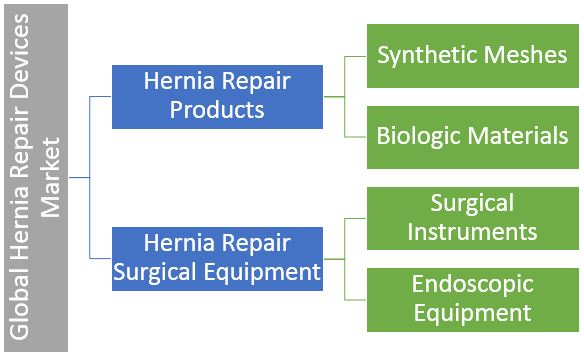
Over the past few years, there has been an increase in the incidence of hernias among the population across the world. According to the National Center for Health Statistics, nearly 5 million Americans suffer from hernias.
Quick Facts About Hernias:
- There are different types of hernias such as inguinal, umbilical, hiatal, femoral, and incisional hernias.
- An inguinal hernia is the most common form, accounting for around 80 percent of all hernia cases.
- Inguinal hernias are around 10 times more common in men than women.
- It has been estimated that over 500,000 American men require hernia repair annually.
- Poor nutrition, smoking, change in lifestyle, and genetic factors are some of the factors that lead to hernias.
- An increase in age and obesity can also cause hernias because of weakened muscles and pressure in the abdomen.
As a result of the growing incidence of hernias, the demand for hernia repair devices is also increasing. This is a huge reason why the Global Hernia Repair Devices Market is expected to post a CAGR of 6.35 percent for the 2013-2018 period. Hernia repair devices are used for the correction of a hernia through procedures such as herniorrhaphy, hernioplasty, and herniotomy.
Types of Hernia Repair Devices:
 Synthetic Meshes
Synthetic Meshes
Synthetic mesh is a sterile woven material designed for implantation within the body. It is widely used in complex hernia repair procedures as it enables faster recovery and causes negligible post-operative pain. It is composed of materials such as polypropylene, polyester, and ePTFE. Polypropylene mesh, made from the network of monofilament fibers with large pores in between, is among the most widely used materials.
Polyester mesh incorporates well and is available with a range of absorbable collagen-based coatings, but shows greater shrinkage compared to other types of meshes such as polypropylene mesh and ePTFE. Polytetrafluoroethylene mesh is soft and flexible microporous mesh. There are increased chances of the recurrence of hernia infections caused by synthetic meshes.
Biologic Materials
Biologic materials include biologic meshes, biologic plugs, and biologic allograft mesh systems. These meshes are derived from animal tissues such as porcine skin or bovine pericardium. These are partially or completely absorbable in nature. Biologic mesh and biologic allograft mesh systems aid in fast recovery and cause negligible post-operative pain. Biologic mesh is widely used for inguinal hernia repair.
Endoscopic Equipment
Endoscopic equipment includes laparoscopes and endoscopes. This equipment is used to visualize the different types of hernias such as inguinal, umbilical, hiatal, femoral, and incisional. This equipment is also used in MI surgery to locate the target site for effective and successful surgery.
Surgical Instruments
Surgical instruments used in hernia repair procedures comprise trocars, hernia fixation devices, dilator sets, dissectors, staplers, and other handheld surgical instruments. Hernia fixation devices enable mesh manipulation, mesh fixation, and skin closure. Trocars placed through the abdomen during laparoscopic surgery act as a portal for the subsequent placement of instruments such as scissors and staplers.
Trends in the Hernia Repair Market:
Increasing Adoption of Tension-free Repair Procedures
There has been an increase in the adoption of tension-free repair procedures for hernias. The Lichtenstein hernioplasty is among the most common tension-free hernia repair procedures. The procedure involves using a piece of mesh to bridge the hernia and decrease the tension on the weakened abdominal wall.
This procedure offers advantages such as reducing the risk of hernia recurrence, causing minimum post-operative problems, reducing the period of hospitalization, and promoting faster healing and shorter recovery time.
Increasing Demand for Advanced Meshes
With the increased adoption of tension-free hernia repair procedures, the demand for advanced meshes has also increased. Biologic meshes restore the natural connections of muscle and tissue in the abdomen. This minimizes the risk of infection and lowers failure rates. These three-dimensional meshes can be applied with ease, and function both as a plug and patch in the hernia site.
Several leading vendors have also developed such products to meet the rising demand. For instance, the GORE DUALMESH PLUS Biomaterial offered by W. L. Gore & Associates Inc. is the first two-surface hernia repair product that contains antimicrobial agents, which inhibit microbial growth.
Growing Acceptance of Robotic Surgeries
Over the last decade, robotic surgeries have gained increased acceptance worldwide. This is because robotic surgeries offer high consistency, accuracy, and reduced possibility of human errors. There have been several strategic collaborations between medical device manufacturers and the developers of robotic surgical equipment recently. The robotic arms allow an increased range of motion and eliminate hand tremor.
They also provide improved 3D visualization. The robotic laparoscopes convert the large hand movements of the surgeon into small ones allowing for delicate work in small spaces. Robotic assistance is considered to have improved outcomes in MI inguinal hernia repair procedures.



